Vue3简介 💭
2020年9月18日,Vue.js发布3.0版本,代号:One Piece(海贼王)
github上的tags地址:https://github.com/vuejs/vue-next/releases/tag/v3.0.0
Vue3新特性
Performance
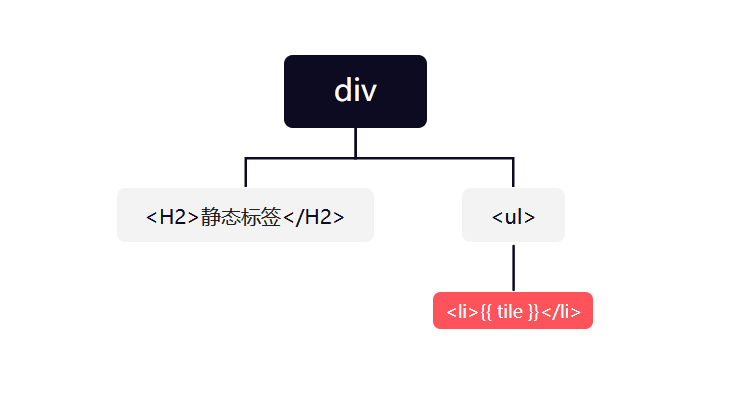
说明
在vue2中,DOM Diff过程中【虚拟DOM转换为真实DOM】,如果视图更新(比如新增了一个节点),会全部进行对比,包括静态的dom节点。而在vue3中会跳过静态节点。
- update性能提高1.3~2倍
- SSR速度提高了2~3倍
Tree shaking
- 打包时,可以将无用模块“剪辑”,仅打包需要的。
Proxy
- Proxy 参考链接: MDN Proxy 直达
- 响应式原理不再基于 Object.defineProperty
Vue2 中的数据劫持
实现原理:Vue2是基于Object.defineProperty实现数据劫持的(get/set)
需要给对象中的每一个属性分别遍历做劫持,对于后期新增的属性是没有做劫持的,vue2中可以基于
$set实现新增属性的劫持。数组类型:对于数组中的每一项没有做劫持,vue2中重写了数组7个方法,后期通过这7个方法修改数组中的某一项,才会让视图重新渲染。
前置知识点:
forEach 特性:
- 优先遍历数字属性
- 无法遍历Symbol类型的私有属性
- 会把私有以及公有中所有可枚举的都遍历「性能比较差」
获取对象中所有属性-包括私有属性
- ES5 写法
/* 拿到obj的所有非 Symbol类型属性 */
let keys = Object.keys(obj);
/* 拿到obj中所有 Symbol 类型的属性,返回一个数组,
包含所有 Symbol 类型的属性名,拼接到 keys 中 */
if (typeof Symbol !== "undefined")
keys = keys.concat(Object.getOwnPropertySymbols(obj));
- ES6 写法
// 使用ES6语法获取所有属性包括私有属性
let keys = Reflect.ownKeys(obj);
检查是否为纯对象
const isPlainObject = function isPlainObject (obj) {
let proto, Ctor;
if (!obj || Object.prototype.toString.call(obj) !== "[object Object]") return false;
proto = Object.getPrototypeOf(obj);
if (!proto) return true;
Ctor = proto.hasOwnProperty('constructor') && proto.constructor;
return typeof Ctor === "function" && Ctor === Object;
};
vue2 中的数据劫持方法
#region
let obj = {
x: 1,
y: { n: 2,m: 3 },
z: [ 10, 20, 30 ]
};
const observe = function observe (obj) {
let proxyObj = JSON.parse(JSON.stringify(obj)); // 对象深拷贝
// 因为 forEach 特性,使用 Reflect拿到所有属性名
let keys = Reflect.ownKeys(obj);
// 1. 遍历所有属性名,使用Object.defineProperty劫持数据
keys.forEach(key => {
Object.defineProperty(obj, key, {
get () {
return proxyObj[key];
},
set (value) {
if (proxyObj[key] === value) return;
proxyObj[key] = value;
// 通知视图渲染
}
});
// 2. 如果属性值是对象,则继续劫持,递归调用observe
let value = obj[key];
if (isPlainObject(value)) {
observe(value);
}
});
return proxyObj; // 操作obj的时候,返回的是代理对象
};
observe(obj);
obj.name = '张三';
/* 在后续更改对象时: 发现 obj.name没有被劫持,这也是vue2中的痛点
当然:vue提供了$set方法,可以解决这个问题 */
#endregion
VS Code使用 #region 折叠代码防止莫名其妙展开 :VS Code使用 #region
* 存在问题:
- 新增属性、删除属性, 界面不会更新。
- 直接通过下标修改数组, 界面不会自动更新。
Vue3 中的数据劫持
实现原理:
- 通过Proxy(代理): 拦截对象中任意属性的变化, 包括:属性值的增、删、改、查。
- 通过Reflect(反射): 对源对象的属性进行操作。
let obj = {
x: 1,
y: { n: 2,m: 3 },
z: [ 10, 20, 30 ]
};
let proxyObj = new Proxy(obj, {
/*
@param target: 被代理的对象
@param key: 是被代理的属性名
@param value: 是被代理的属性值
*/
get(target, key) { // 获取值
return Reflect.get(target, key);
},
set(target, key, value) { // 设置值
if (Reflect.get(target, key) === value) return;
Reflect.set(target, key, value);
console.log('视图更新...'); // 通知视图渲染
},
deleteProperty(target, key) {
Reflect.deleteProperty(target, key);
}
})
proxyObj.name = '张三'; // 会触发视图更新
Vue3 中的响应式数据,是基于ES6中的 Proxy 实现的
Proxy除了提供get/set监听器之外,还提供了其它大量的监听函数,当我们操作对象的时候,可以做到全方位劫持监听。 对数组的处理也很友好。Proxy无需自己依次遍历对象的每个属性,只需要代理整个对象,则所有属性都做代理了,哪怕是后期自己新增的属性也会做代理。Proxy默认也只是对对象中第一层做代理,而vue3中基于递归的方式,也实现了深层次代理。ES6的API,不兼容IE。
新的内置组件
1. Fragment 碎片化节点
TIP
- 在Vue3中: 不再限于模板中的单个根节点, 组件可以没有根标签。
- 内部会将多个标签包含在一个
<Fragment />虚拟元素中,类似于React中的<> </>, 可以有效减少标签层级, 减小内存占用。
<template>
<div>
<header>
<button @click="Login">
登入
</button>
</header>
<main />
</div>
</template>
vue3中可以有多个根节点:
<template>
<header>
<button @click="Login">
登入
</button>
</header>
<main />
</template>
2. <Teleport /> 传送门
TIP
<Teleport />是一种能够将我们的模板渲染至指定DOM节点,不受父级style、v-show等属性影响,但data、prop数据依旧能够共用的技术;- 类似于 React 的
<Portal> [ˈpɔːtl],译作传送门。
主要解决的问题 因为Teleport节点挂载在其他指定的DOM节点下,完全不受父级style样式影响:
两个属性:
to指定传送到哪个容器disabled传送门开关, 默认开启, 使用这个属性时一般配合响应式动态控制。
<script>
export default {
data() {
return {
content: 'This is the app'
}
}
}
</script>
<template>
<router-view />
<!-- 把当前组件中的部分内容抽离出来,放置在页面非 #app的容器中,
基于to指定放在哪个容器中 -->
<Teleport to="#other" disabled="true">
<h1>Other</h1>
<h4>This is the other page</h4>
<p> {{ content }}</p>
</Teleport>
</template>
注意
如果设置了 <Teleport/>节, 点必须挂载在#app节点或者其他已经存在的节点下,否则会报错。
<!DOCTYPE html>
<html lang="">
<head>
<meta charset="utf-8">
<meta http-equiv="X-UA-Compatible" content="IE=edge">
<meta name="viewport" content="width=device-width,initial-scale=1.0">
<link rel="icon" href="<%= BASE_URL %>favicon.ico">
<title><%= htmlWebpackPlugin.options.title %></title>
</head>
<body>
<div id="app"></div>
<!-- 设置渲染容器 -->
<div id="other"></div>
</body>
</html>
效果如下: 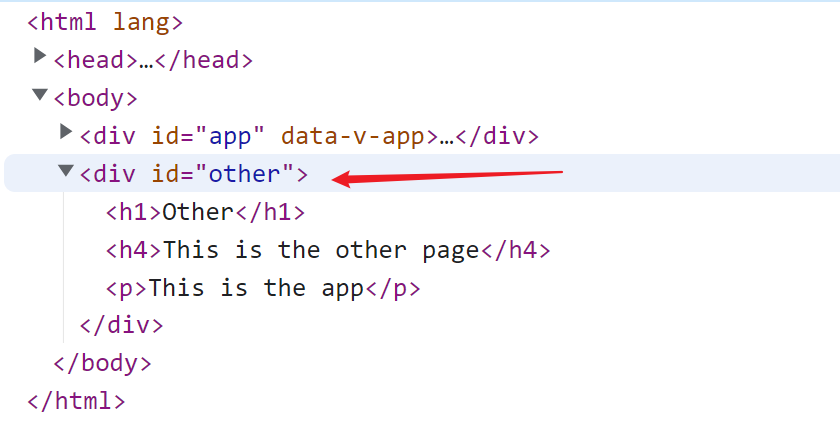
官方栗子是点击按钮的时候出现一个弹窗,但是因为弹窗和当前页面是同一级,如果我们把当前页面的颜色更改后,比如设置了当前页面透明度 opacity: 0.8;,那么弹窗的样式也会受影响,这个时候我们就可以使用传送门解决此类问题。
实例:
- 如果设置了
<Teleport/>,必须先在组件里设置节点
下面的案例中,假设页面头部有一个搜索框,我们在搜索框搜索时,希望列表组件 (兄弟组件)监听搜索框组件的值。
<script setup name="Navbar">
</script>
<template>
<nav class="navbar navbar-light bg-white navbar-expand-lg border-bottom">
<div class="container">
<div class="d-flex align-items-center">
<img class="icon me-2" src="/vite.svg" alt="">
<a class="navbar-brand" href="#"><strong>Vue</strong> 图片上传</a>
</div>
<!-- 搜索框传送容器 -->
<div id="search-form" />
</div>
</nav>
</template>
<style lang="scss" scoped>
.icon {
width: 24px;
height: 24px;
}
</style>
定义搜索框组件:
<script setup>
defineProps({
modelValue: {
type: String
}
})
const emits = defineEmits(['update:modelValue'])
function handleEnterKey(event) {
emits('update:modelValue', event.target.value)
}
</script>
<template>
<div class="mt-2 mt-md-0">
<input :value="modelValue" class="form-control me-2" type="text" placeholder="Search in Drive" aria-label="Search" @keydown.enter="handleEnterKey">
</div>
</template>
<style lang="scss" scoped>
</style>
在列表组件中使用:
<script setup>
import axios from 'axios'
import { reactive, watchEffect } from 'vue'
import SearchForm from '../components/SearchForm.vue'
import FileItem from '../components/FileItem.vue'
const files = ref([])
const query = reactive({
_sort: 'name',
_order: 'desc',
q: ''
})
// TODO 使用watchEffect监听数据发生改变,watchEffect每次进入页面都会执行
watchEffect(async () => {
// new URLSearchParams(query) 把对象转换为&链接的请求参数
const { data } = await axios.get(
`http://localhost:3030/files?${ new URLSearchParams(query)}`
)
files.value = data
})
</script>
<template>
<div class="container py-3">
<!-- 请求的列表 -->
<div class="row">
<FileItem v-for="file in files" :key="file.id" :file="file" />
</div>
<!-- 使用传送门 -->
<Teleport to="#search-form">
<SearchForm v-model="query.q" />
</Teleport>
</div>
</template>
<style lang="scss" scoped>
</style>
效果: 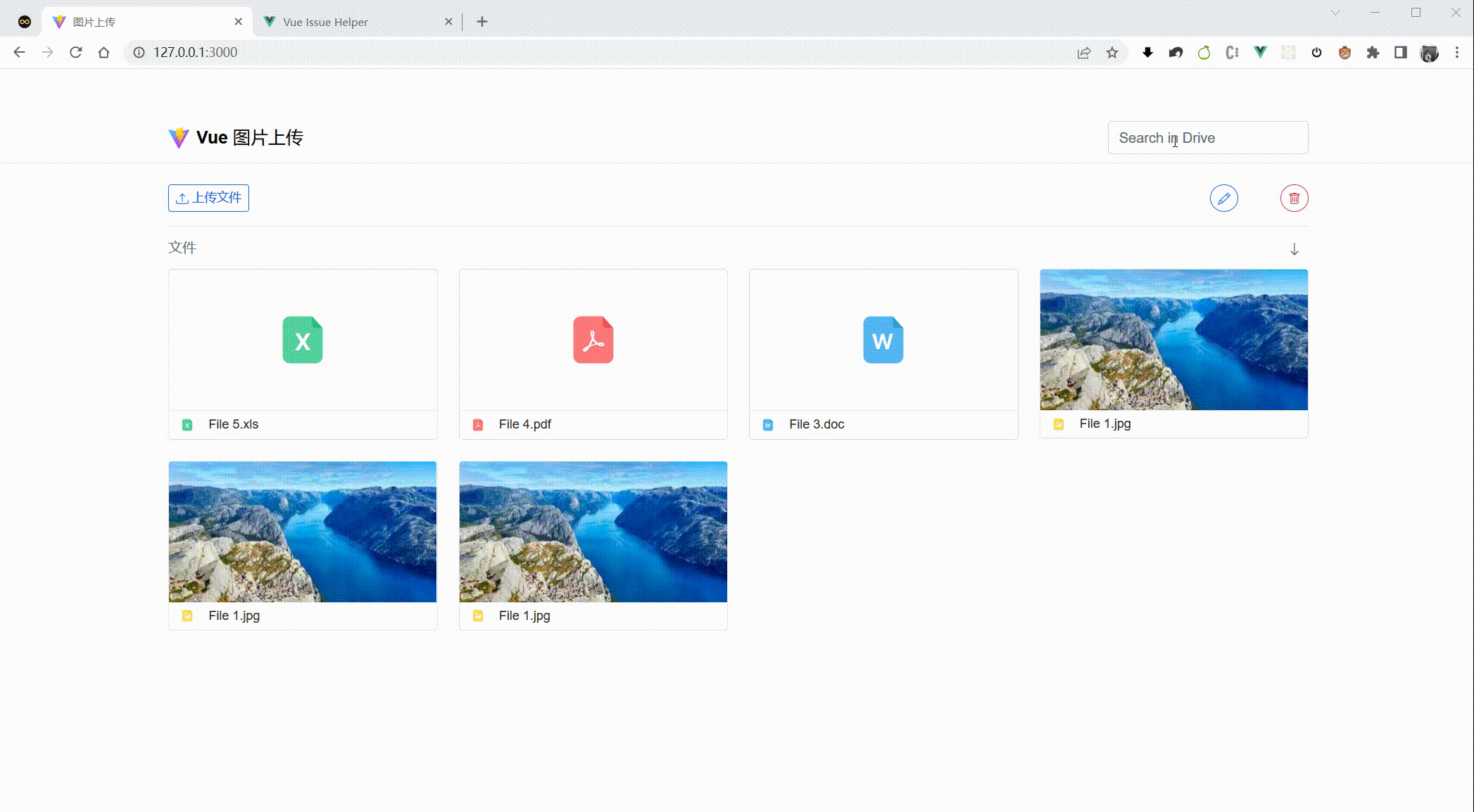
3. <Suspense /> 异步组件
WARNING
🐾 实验性功能: <Suspense> 是一项实验性功能。不能保证它会成为稳定版,而且在那之前,相关 API 也可能会发生变化。
- 可在嵌套层级中等待嵌套的异步依赖项
- 等待异步组件时渲染一些额外内容,让应用有更好的用户体验
使用:
- 定义一个 异步的子组件
asyncComponents.vue
<script setup>
function query() {
return new Promise((resolve, reject) => {
setTimeout(() => {
resolve({
data:{
id: '1000007',
name: 'liaoyi',
age: 22,
url: 'https://canxiu.oss-cn-hangzhou.aliyuncs.com/2022/user.jpg',
desc:'Hello 2023!!'
}
})
}, 2000)
})
}
const { data } = await query()
</script>
<template>
<h2>用户信息</h2>
<div> ID: {{ data.id }} </div>
<div> 姓名:{{ data.name }} </div>
<div> 年龄:{{ data.age }} </div>
<div> 头像:{{ data.url }} </div>
<div> 描述:{{ data.desc }} </div>
</template>
- 父组件中使用
TIP
<Suspense > 组件内置两个插槽,第一个插槽是 default 插槽,我们把异步组件放在里面,第二个插槽为fallback 插槽,我们可以传入异步组件没有加载成功时显示的样式。
<script>
import { defineAsyncComponent } from 'vue'
import syncVue from '@/components/asyncComponents.vue'
</script>
/* 非Setup使用 */
<script setup>
// 导入 defineAsyncComponent 用于注册异步组件
export default {
components: { syncVue }
}
// 导入异步组件
const syncVue = defineAsyncComponent(() =>
import('@/components/asyncComponents.vue')
)
</script>
<!-- /* Setup使用 */ -->
<template>
<h2>使用异步组件</h2>
<Suspense>
<template #default>
<syncVue />
</template>
<!-- 设置异步组件没有加载成功时显示的样式 -->
<template #fallback>
正在努力加载中...
</template>
</Suspense>
</template>

4. Custom Renderer API
- 自定义渲染器API
- 用户可以尝试WebGL自定义渲染器
TIP
在vue中,我们可以虚拟DOM转换为的真实DOM元素,然后以HTML网页形式展现在页面上,在vue3中,用户可以自定义渲染器,比如把虚拟DOM转换成canvas画布,以图片的形式展现在网页上。
创建Vue3 项目
官方文档:vue-cli vite官网:https://vitejs.cn
1.使用 vue-cli 创建
## 查看@vue/cli版本,确保@vue/cli版本在4.5.0以上
vue --version
## 安装或者升级你的@vue/cli
npm install -g @vue/cli
## 创建
vue create vue_test
## 启动
cd vue_test
npm run serve
2.使用 vite 创建
- 什么是vite?—— 新一代前端构建工具。
- 优势如下:
- 开发环境中,无需打包操作,可快速的冷启动。
- 轻量快速的热重载(HMR)。
- 真正的按需编译,不再等待整个应用编译完成。
传统构建 与 vite构建对比图

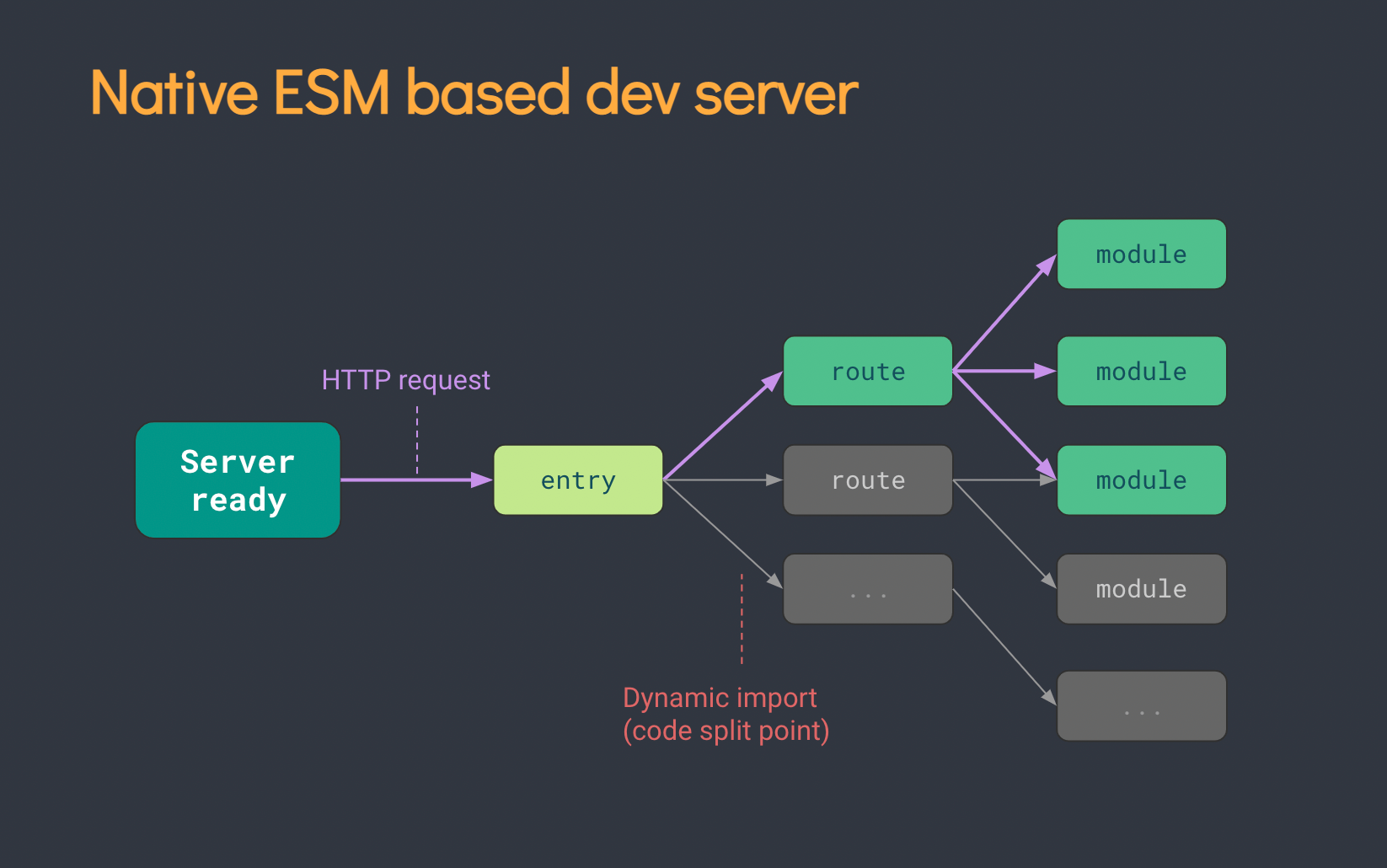
## 创建工程
npm init vite-app <project-name>
## 进入工程目录
cd <project-name>
## 安装依赖
npm install
## 运行
npm run dev
setup
info
setup是Vue3.0 中一个新的配置项,值为一个函数。**setup **是所有 Composition API(组合API)“ 表演的舞台 ”。组件中所用到的:数据、方法等等,均要配置在setup中。
- 初始化时,setup 在 props和 beforeCreate 之间调用,且只在组件加载时执行。
- setup 函数可以接收 props 和 context 上下文
- this 在 setup() 中不可用
setup 两种返回值
- 🌟 若返回一个对象,则对象中的属性、方法, 在模板中均可以直接使用。(重点关注!)
<script>
export default {
name: 'HelloWorld',
setup() {
const name = '张三'
const age = 18
function sayHello() {
alert(`我叫${name},我${age}岁了,你好啊!`)
}
function test2() {
console.log(name, age)
}
return { name, age, sayHello, test2 }
}
}
</script>
- 若返回一个渲染函数:则可以自定义渲染内容。(了解)
<!-- // 注意:如果是返回一个渲染函数,那么此页面上的原有样式将会被覆盖。 -->
<script>
// 我们在vue2中的main.js中已经见过 h 渲染函数了,在vue3中使用需要导入。
import { h } from 'vue'
export default {
name: 'HelloWorld',
// return ()=> return { h('h1','2022') }
//返回一个函数(渲染函数),这个渲染函数必须把h函数调用结果 return 出去。
// 调用 h函数的时候传入两个参数,第一个参数是dom元素,第二个参数是dom元素里的内容。
return ()=> h('h1','你好 2022 !')
}
</script>
注意
- 尽量不要与Vue2.x配置混用
- Vue2.x配置(data、methos、computed...)中可以访问到setup中的属性、方法。
- 但在setup中不能访问到Vue2.x配置(data、methos、computed...)。
- 如果有重名, setup优先。
setup不能是一个async函数,因为返回值不再是return的对象, 而是promise, 模板看不到return对象中的属性。(后期也可以返回一个Promise实例,但需要Suspense和异步组件的配合)
- 现在的版本已经支持!
setup的两个注意点
setup执行的时机
在beforeCreate之前执行一次,this是 undefined
setup接收的参数
TIP
- props:包含:组件外部传递过来,且组件内部声明接收了的属性。
- context:上下文对象
attrs: 包含组件外部传递过来,但没有在props配置中声明的属性, 相当于this.$attrs。slots: 收到的插槽内容, 相当于this.$slotsemit: 分发自定义事件的函数, 相当于this.$emit
常用 Composition API
官方文档: https://v3.cn.vuejs.org/guide/composition-api-introduction.html
ref
ref(reference) 函数是vue3中新增的函数,常用于定义普通数据类型的响应式数据。
- 返回一个 RefImpl 对象 (ES6中的class类);
- 必须操作该对象的value值改变数据 (状态)
- 模板中读取数据: 不需要
.value,直接:<div></div> - 响应式依然是靠
Object.defineProperty()的get与set完成的 。
<script>
import { ref } from "vue";
export default {
setup() {
let supNum = ref(10);
let oppNum = ref(5);
// 如果想修改值,需要操作 value 值
oppNum.value ++
return { supNum,oppNum }
}
}
</script>
TIP
对于对象类型的数据实现响应式 :内部 "求助" 了Vue3 中的一个新函数—— reactive函数。
reactive
定义一个对象或数组类型的响应式数据(基本类型不要用它,用ref函数)
- 等同于 vue2 中的
Vue.observable() - 响应式转换是 "
深层的":会影响对象内部所有嵌套的属性。
<template>
<p>{{ state.supNum }}</p>
<p>{{ state.oppNum }}</p>
<p>{{ state.arr[0] }}</p>
<button @click="change(0)">
点击修改数据
</button>
</template>
import { reactive } from "vue";
export default {
setup() {
// 比Object.defineProperty好用在于:
// 对于数据或者并未初始化的对象成员,都可以随意修改值,而且具备响应式的效果
// const 代理对象= reactive(源对象)
let state = reactive({
supNum: 0,
oppNum: 0,
arr: [10, 20]
});
let change = lx => {
lx === 0 ? state.supNum++ : state.oppNum++;
state.arr[0] = state.arr[0] + 1;
};
return {
state,
change
};
}
};
reactive 定义数组异步赋值问题
reactive 生成的是一个 proxy 代理对象,不能直接赋值,否则会丢失响应式。
我们来看一个例子: 下面代码中,如果直接这样赋值,页面是不会变化,因为会脱离响应式
<script setup lang="ts">
import { reactive } from 'vue'
let list = reactive<string[]>([])
function getData() {
setTimeout(() => {
list = ['钟馗', '姜子牙', '杨戬', '哪吒']
console.log(list)
}, 1000)
}
</script>
<template>
<ul>
<li v-for="(name, index) in list" :key="index">
{{ name }}
</li>
</ul>
<button @click="getData">
获取异步数据
</button>
</template>
解决方案:
- 使用数组方法
push
<script setup lang="ts">
import { reactive } from 'vue'
const list = reactive<string[]>([])
function getData() {
setTimeout(() => {
const arr = ['钟馗', '姜子牙', '杨戬', '哪吒']
person.push(...arr)
console.log(list)
}, 1000)
}
</script>
- 包裹一层对象再修改
<script setup lang="ts">
import { reactive } from 'vue'
const list = reactive<{ arr: string[] }>({ arr: [] })
function getData() {
setTimeout(() => {
list.arr = ['钟馗', '姜子牙', '杨戬', '哪吒']
console.log(list)
}, 1000)
}
</script>
<template>
<ul>
<li v-for="(name, index) in list.arr" :key="index">
{{ name }}
</li>
</ul>
<button @click="getData">
获取异步数据
</button>
</template>
reactive 丢失响应式问题 Vu3巨坑
如果你要替换整个数组还要保持响应式,要么用 ref ,要么用 splice(0) 清空数组,然后再 push(..item)。
reactive配合toRefs使用
上面的代码中使用 state.xxx 操作比较麻烦,我们应该可以想到使用解构赋值的方式 return{ ...state }导出数据, 但是,如果 直接使用解构的方式,会丢失响应式。
解决办法:可以基于 toRefs 函数,把state状态中的每一项都变为单独的 RefImpl对象。
<template>
<p>{{ supNum }}</p>
<p>{{ oppNum }}</p>
<p>{{ arr[0] }}</p>
<button @click="change(0)">
点击修改数据
</button>
</template>
<stript lang="ts">
import { reactive, toRefs } from "vue";
export default {
setup() {
let state = reactive({
supNum: 0,
oppNum: 0,
arr: [10, 20]
});
let change = lx => {
lx === 0 ? state.supNum++ : state.oppNum++;
state.arr[0] = state.arr[0] + 1;
};
return {
...toRefs(state),
change
};
}
};
</stript>
使用 ref 获取DOM元素
在vue3没有this,那我们如何像在vue2中通过refs来操作dom元素呢 ?
我们可以通过响应式对象的方式获取DOM元素:
<template>
<!-- 把setup定义的ref响应对象作为dom元素上的ref属性 -->
<h3 ref="root">{{ title }}</h3>
</template>
import { ref, onMounted } from "vue";
export default {
setup() {
let title = ref("你好,2022!"),
// Vue3中获取DOM元素:把RefImpl对象作为元素的ref属性值,
// 这样基于“RefImpl对象.value”可以获取此DOM
let root = ref(); // 和 let root = ref(null) 等价
onMounted(() => {
// 获取DOM元素
console.log(root.value);
});
return {
title,
root
};
}
}
<script setup lang="ts">
import { ref, onMounted } from "vue"
let title = ref("你好,2022!")
// Vue3中获取DOM元素:把RefImpl对象作为元素的ref属性值,
// 这样基于“RefImpl对象.value”可以获取此DOM
let root = ref<HTMLDivElement>()
onMounted(() => {
// 获取DOM元素
console.log(root.value?.innerText);
})
<template>
// <!-- 把setup定义的ref响应对象作为dom元素上的ref属性 -->
<h3 ref="root"> {{ title }} </h3>
</template>
计算属性和监听器
computed
传入一个 getter 函数,返回一个默认不可手动修改的 ref 对象。计算属性只有当依赖的属性的值发生变化的时候,才会触发他的更改,如果依赖的值不发生变化,使用的是缓存中的属性值。
在vue2中的计算属性我们是可以直接修改值的,但是vue3中如果不适应setup语法糖,如果你尝试那么做,控制台会报错:
<script>
import { computed, ref } from 'vue'
export default {
setup() {
const count = ref(1)
const plusOne = computed(() => count.value + 1)
console.log(plusOne.value) //2
// 这样获取的计算属性值是只读的,当我们尝试去修改的时候,
// 报警告:computed value is readonly
plusOne.value++ //错误!
return { count, plusOne }
}
}
</script>
函数形式
import { computed, reactive, ref } from 'vue'
let price = ref(0)//$0
let m = computed<string>(()=>{
return `$` + price.value
})
price.value = 500
对象形式
传入一个拥有 get 和 set 函数的对象,创建一个可手动修改的计算状态,写法如下:
<script setup lang="ts">
import { computed, reactive, ref } from 'vue'
const price = ref<number | string>(1) //$0
const state = reactive({
supNum: 12,
oppNum: 11
})
const mul = computed({
get: () => {
return price.value
},
set: (value) => {
price.value = `set${ value}`
}
})
mul.value = 666
console.log(mul.value) // set666
const ratio = computed({
get: () => {
const total = state.supNum + state.oppNum
return total === 0
? '--'
: `${((state.supNum / total) * 100).toFixed(2) }%`
}
})
</script>
<template>
<div>{{ mul }}</div>
<div @click="mul = 100">
click
</div>
</template>
小案例: 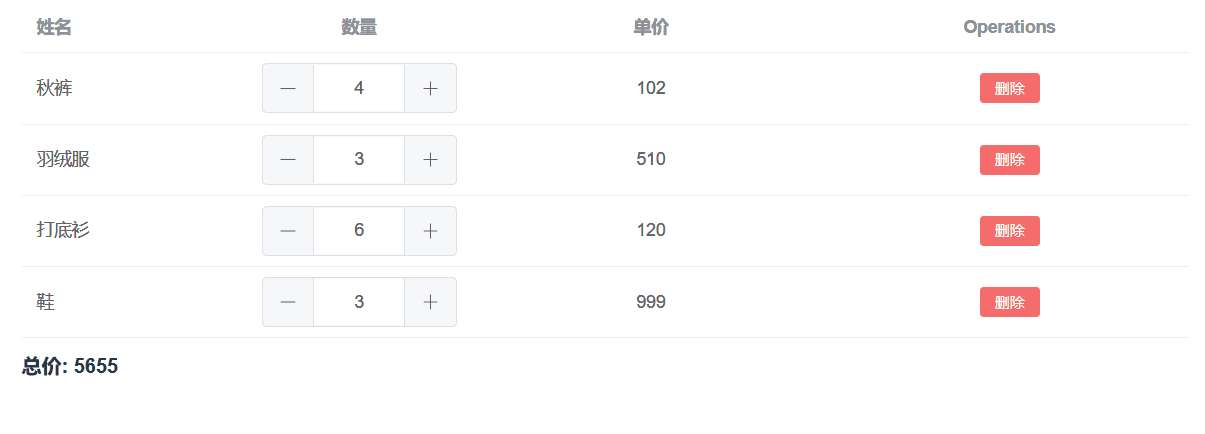
代码实现:
<script setup lang="ts">
import { computed, reactive, ref } from 'vue'
interface Shop {
name: string
num: number
price: number
}
const $total = ref<number>(0)
const data = reactive<Shop[]>([
{
name: '秋裤',
num: 4,
price: 102
},
{
name: '羽绒服',
num: 3,
price: 510
},
{
name: '打底衫',
num: 6,
price: 120
},
{
name: '鞋',
num: 3,
price: 999
}
])
$total.value = computed<number>(() => {
return data.reduce((prev, next) => {
return prev + (next.num * next.price)
}, 0)
})
function handleDelete(index: number): void {
data.splice(index, 1)
}
</script>
<template>
<el-table :data="data" style="width: 100%">
<el-table-column prop="name" label="姓名" width="180" />
<el-table-column label="数量" width="180" align="center">
<template #default="scope">
<div style="display: flex; align-items: center">
<el-input-number v-model="scope.row.num" :step="1" size="large" :min="0" />
</div>
</template>
</el-table-column>
<el-table-column prop="price" label="单价" align="center" />
<el-table-column label="Operations" align="center">
<template #default="scope">
<el-button size="small" type="danger" @click="handleDelete(scope.$index)">
删除
</el-button>
</template>
</el-table-column>
</el-table>
<div style="display: flex; align-items: flex-end; padding-top: 10px; font-weight: bold">
总价: {{ $total }}
</div>
</template>
watch
与Vue2.x中watch配置功能一致 :侦听特定的数据源,并在单独的回调函数中执行副作用。
两个小“坑”:
- 监视reactive定义的响应式数据时:
oldValue无法正确获取、强制开启了深度监视(deep配置失效)。 - 监视
reactive定义的响应式数据中某个属性时:deep配置有效。
//情况一:监视ref定义的响应式数据
watch(sum,(newValue,oldValue)=>{
console.log('sum变化了',newValue,oldValue)
},{immediate:true})
//情况二:监视多个ref定义的响应式数据
watch([sum,msg],(newValue,oldValue)=>{
console.log('sum或msg变化了',newValue,oldValue)
})
/* 情况三:监视reactive定义的响应式数据
若watch监视的是reactive定义的响应式数据,则无法正确获得oldValue!!
若watch监视的是reactive定义的响应式数据,则默认强制开启了深度监视
*/
watch(person,(newValue,oldValue)=>{
console.log('person变化了',newValue,oldValue)
},{immediate:true,deep:false}) //此处的deep配置不再奏效
//情况四:监视reactive定义的响应式数据中的某个属性
watch(()=>person.job,(newValue,oldValue)=>{
console.log('person的job变化了',newValue,oldValue)
},{immediate:true,deep:true})
//情况五:监视reactive定义的响应式数据中的某些属性
watch([()=>person.job,()=>person.name],(newValue,oldValue)=>{
console.log('person的job变化了',newValue,oldValue)
},{immediate:true,deep:true})
//特殊情况
watch(()=>person.job,(newValue,oldValue)=>{
console.log('person的job变化了',newValue,oldValue)
},{deep:true}) //此处由于监视的是reactive素定义的对象中的某个属性,所以deep配置有效
注意: ref创建的状态直接监听 reactive创建的某个状态要写成函数。
监听路由
/* 监听路由变化,切换子路由页面时保持tab选中状态 */
watch(
() => router.currentRoute.value.path,
(newValue: string) => {
activeName.value = newValue.split('/')[2]
},
{ immediate: true }
)
watch 的参数
import { ref, watch } from 'vue'
const message = ref({
nav:{ bar:{ name:'' } }
})
/* watch 的参数:
* 第一个参数:监听源
* 第二个参数回调函数cb(newVal,oldVal)
* 第三个参数一个options配置项是一个对象
{
immediate:true //是否立即调用一次
deep:true //是否开启深度监听
flush:'pre' // 用于设置watch的执行顺序 (watch基本用不上)
// pre: 组件更新前调用,sync: 同步调用, post: 组件更新后执行
}
*/
watch(message, (newVal, oldVal) => {
// 如果监听的是引用数据类型,那返回的新值和旧值都一样
console.log('新的值----', newVal)
console.log('旧的值----', oldVal)
}, {
immediate:true,
deep:true
})
监听多个ref
注意:监听多个ref时应该传入一个数组:
import { reactive, ref, watch } from 'vue'
const message = ref('')
const message2 = ref('')
watch([message, message2], (newVal, oldVal) => {
console.log('新的值----', newVal)
console.log('旧的值----', oldVal)
})
监听reactive
使用reactive监听深层对象开启和不开启 deep 效果一样 (deep失效)
import { reactive, ref, watch } from 'vue'
const message = reactive({
nav:{ bar:{ name:'' } }
})
watch(message, (newVal, oldVal) => {
console.log('新的值----', newVal)
console.log('旧的值----', oldVal)
})
监听单个值时有效:
注意:
如果要监听单一属性,我们需要使用一个get函数返回我们需要监听的属性值
import { ref, watch ,reactive} from 'vue'
let message = reactive({
name:'',
foo:{
bar:{
name: 'liaoyi',
age: 22
}
}
})
watch(()=>message.foo.bar.name, (newVal, oldVal) => {
console.log('新的值----', newVal)
console.log('旧的值----', oldVal)
})
watchEffect
立即执行传入的一个函数,并响应式追踪其依赖,并在其依赖变更时重新运行该函数
<script setup lang="ts">
// 第一次加载组件,会触发watchEffect回调
// watchEffect所指定的回调中用到的数据只要发生变化,就会触发callback执行
// 类似于周期函数中的 mounted和updated「只不过只有更改了依赖的状态才会在更新后执行」
const message = ref<string>('hello')
const message2 = ref<string>('2023')
// 用到几个响应式数据就会监听几个,且是非惰性 会默认调用一次(立即调用)
watchEffect(() => {
console.log('watchEffect配置的回调执行了', message.value,)
console.log('watchEffect配置的回调执行了', message2.value)
})
</script>
<template>
<input v-model="message" type="text">
<input v-model="message2" type="text">
</template>
清除副作用
可以在触发监听之前会调用一个函数可以处理你的逻辑,例如防抖。
import { ref, watchEffect } from 'vue'
const message = ref<string>('hello')
const message2 = ref<string>('2023')
watchEffect((oninvalidate) => {
console.log('message', message.value)
console.log('message2', message2.value)
// 回调函数会先执行
oninvalidate(()=>{
console.log('before')
})
})
停止监听
我们可以手动停止停止 watchEffect 监听,跟踪 watchEffect 返回一个函数, 调用之后将停止更新。
<script setup lang="ts">
const message = ref<string>('hello')
const message2 = ref<string>('2023')
const stop = watchEffect((oninvalidate) => {
console.log('message', message.value)
console.log('message2', message2.value)
oninvalidate(()=>{
console.log('before')
})
})
const stopWatch = () => stop()
</script>
<template>
<input v-model="message" type="text">
<input v-model="message2" type="text">
<button @click="stopWatch">
停止监听<button />
</button>
</template>
其它的一些配置项
副作用刷新时机 flush配置, 一般使用post
| pre | sync | post |
|---|---|---|
| 组件更新前执行 | 强制效果始终同步触发 | 组件更新后执行 |
// onTrigger是vue给我们在开发环境时提供的debugger函数 可以帮助我们调试 watchEffect
import { ref, watchEffect } from 'vue'
const message = ref<string>('')
watchEffect((oninvalidate) => {
console.log('message2', message.value)
}, {
flush:'post',
onTrigger() {
debugger
}
})
watch 和 watchEffect 总结:
- watch 的套路:
- 既要指明监视的属性,也要指明监视的回调。
- watchEffect 的套路:
- 不用指明监视哪个属性,监视的回调中用到哪个属性,那就监视哪个属性。
- watchEffect 有点像
computed,但computed注重的计算出来的值(回调函数的返回值),所以必须要写返回值;而watchEffect更注重的是过程(回调函数的函数体),所以不用写返回值。
生命周期
简单来说就是一个组件从创建到销毁的过程,称为生命周期。
vue2.x的生命周期

vue3 的生命周期
生命周期钩子
Vue3.0中可以继续使用Vue2.x中的生命周期钩子,但有两个被更名:
beforeDestroy改名为beforeUnmountdestroyed改名为unmounted
Vue3.0也提供了 Composition API 形式的生命周期钩子,与Vue2.x中钩子对应关系如下:beforeCreate===> setup() 根元素还不存在( 啥也没有) created=======> setup() 有数据但没有 DOM beforeMount ===> onBeforeMount 有数据但没有 DOM mounted=======> onMounted 有数据也有 DOM beforeUpdate===> onBeforeUpdateupdated =======> onUpdatedbeforeUnmount ==> onBeforeUnmountunmounted =====> onUnmounted
注意:在我们使用Vue3 组合式API时,是没有 beforeCreate 和 created 这两个生命周期的 。
| 选项式API | Hook inside setup | 说明 |
|---|---|---|
| beforeCreate | Not needed* | |
| created | Not needed* | |
| beforeMount | onBeforeMount | 组件创建之前,无法获取dom |
| mounted | onMounted | 创建完成,可以获取dom |
| beforeUpdate | onBeforeUpdate | 更新前,获取的是更新前dom |
| updated | onUpdated | 更新完成,获取的是更新后的dom |
| beforeUnmount | onBeforeUnmount | 组件销毁之前 |
| unmounted | onUnmounted | 组件销毁完成 |
| errorCaptured | onErrorCaptured | |
| renderTracked | onRenderTracked | |
| renderTriggered | onRenderTriggered | 接收一个target,用于调试 |
| activated | onActivated | |
| deactivated | onDeactivated |
组件通讯
defineProps 父传子
💭
父组件通过 v-bind 绑定一个数据,子组件通过defineProps接收, 且无须引入,可以在模板直接使用。
父组件:
<script setup>
import { reactive } from 'vue'
const list = reactive(['子鼠', '丑牛', '寅虎', '卯兔'])
const item = reactive({ name: 'liaoyi', phone: '13245666776' })
</script>
<template>
<Children title="我是标题" :list="list" :item="item" />
</template>
子组件:
<script setup>
// defineProps无需 import 导入
defineProps({
title:{
type: String,
default: 'Hello 2023!'
},
list: {
type: Array,
required: true // 设置为必传
},
item:{
type: Object,
default: () => {}
}
})
</script>
<template>
<div> {{ title }} </div>
<div v-for="(item, index) in list" :key="index">
{{ item }}
</div>
<div> 姓名:{{ item.name }} 电话: {{ item.phone }}</div>
</template>
💭
如果我们在 script 标签中想使用 props ,需要用一个变量接收。即使我们用常量接收了 `props,我们在模板中还是可以直接使用,不需 {{props.item}}
<script setup>
const props = defineProps({
title: {
type: String,
default: 'Hello 2023!'
},
list: {
type: Array,
required: true // 设置为必传
},
item: {
type: Object,
default: () => {}
}
})
// 使用 props
console.log('props', props.item)
</script>
在ts中使用
如果你使用 ts ,我们可以使用传递字面量类型的纯类型语法做为参数的方式接收props:
<script setup lang="ts">
defineProps<{
title: string
list: number[]
item: object
}>()
</script>
<template>
<div> {{ title }} </div>
<div v-for="(item, index) in list" :key="index">
{{ item }}
</div>
<div> 姓名:{{ item.name }} 电话: {{ item.phone }}</div>
</template>
上面的写法,无法约束props的默认值,我们可以使用 TS 特有的默认值方式:
💭
withDefaults( ) 函数也是无须引入开箱即用接收一个 defineProps 函数,第二个参数是给一个对象,我们可以设置不同props的默认值。
<script setup lang="ts">
interface Item {
name?: string
phone?: string
}
// 采用ts专有声明,有默认值
/* interface Props {
title: string;
list?: string[];
item: Item;
} */
interface Props {
title: string
list?: string[]
item: Item
}
withDefaults(defineProps<Props>(), {
title: '张三',
list: () => []
})
</script>
<template>
<div>{{ title }}</div>
<div v-for="(item, index) in list" :key="index">
{{ item }}
</div>
<div>姓名:{{ item.name }} 电话: {{ item.phone }}</div>
</template>
<!-- 父组件 -->
<Children :paging="paging" />
<script setup lang="ts">
const paging = reactive({
limit: 101,
total: 999
})
</script>
// 子组件
<script setup lang="ts">
interface IPagenation {
limit: number
total: number
page?: number
pagesizes?: Array<number>
background?: boolean
layout?: any
autoScroll?: boolean
}
const props = withDefaults(
defineProps<{
paging: IPagenation
}>(),
{
paging: (): IPagenation => {
return {
limit: 1,
total: 9
}
}
}
)
</script>
<template>
<div>{{ paging.limit }} -- {{ paging.total }} </div>
</template>
defineEmits 子向父事件传递
<script setup lang="ts">
import { reactive } from 'vue'
/* 非ts */
// const emit = defineEmits(['on-click'])
/* ts专有 */
const emit = defineEmits<{
(e: 'on-click', list: number[]): void
// (e: 'ochange', name: string ): void; 多个写法
}>()
const list = reactive<number[]>([4, 5, 6])
function clickThis() {
emit('on-click', list)
}
</script>
<template>
<button @click="clickThis">
点我给父组件传值
</button>
</template>
父组件接收自定义事件:
<script setup lang="ts">
function getList(list: number[]) {
console.log('父组件接受子组件数据', list)
}
</script>
<template>
<children @on-click="getList" />
</template>
defineExpose 子向父暴露属性
💭
在使用vue2开发时,我们经常使用 ref 来获取子组件的数据、方法等,但在vue3 中setup语法糖模式时,会返回 {_v_skin:true} 这个信息,表示数据无法响应,这个时候我们需要使用 defineExpose 来暴露当前组件的一些属性、方法。点击查看 vue3 definEexpose。
子组件暴露方法和属性:
<script setup lang="ts">
import { reactive, ref } from 'vue'
const list = reactive<number[]>([4, 5, 6])
const title = ref('Hello 2023!!!')
function handleNodeClick() {
console.log('我是暴露的方法~~')
}
// 将属性、方法暴露出去
defineExpose({
list,
title,
name: 'liaoyi',
handleNodeClick,
open: ()=>{
console.log('~~~~~')
}
})
</script>
<template>
<div> 我是子组件 </div>
</template>
我们从父组件获取子组件实例通过ref
<script setup lang="ts">
// ts写法 --这样获取是有代码提示的
// 使用ts自带的工具 InstanceType,它接收一个泛型,我们再通过 typeof 读取 childRef 的类型
const childRef = ref<InstanceType<typeof childRef>>()
/* 非ts */
// const childRef = ref()
function handleClick() {
console.log(childRef.value)
childRef.value.handleNodeClick()
}
</script>
<template>
<children ref="childRef" @on-click="getList" />
<button @click="handleClick">
获取children组件暴露参数
</button>
</template>
// 子组件 tree
const handleNodeClick = () => {
console.log('要执行的方法')
}
//将方法暴露出
defineExpose({ handleNodeClick})
// 父组件 通过ref
<tree :show="show" ref="treeRef"> </tree>
const treeRef = ref()
provide 、inject 依赖注入
💭
依赖注入用于实现祖与后代组件间通信 ,父组件有一个 provide 选项来提供数据,后代组件有一个 inject 选项来接收使用这些数据 。
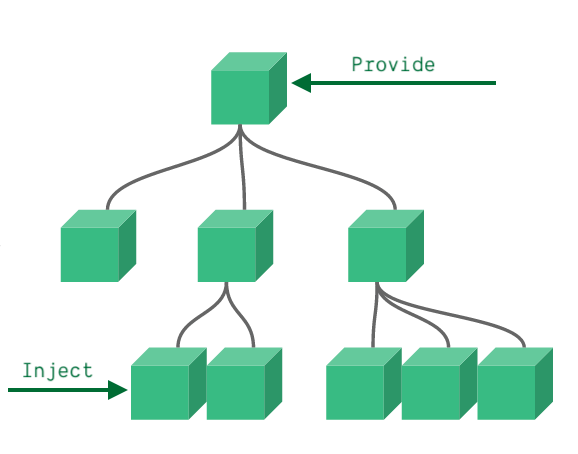
具体写法
let car = reactive({name:'奔驰',price:'40万'})
// 传递响应式数据
provide('car',car)
const car = inject('car')
实例:
<script setup lang="ts">
import { provide, readonly, ref } from 'vue'
const colorVal = ref<string>('red')
// provide 默认是可以让子组件修改的
provide('color', colorVal)
// 如果不想要被修改
provide('bg', readonly(colorVal))
</script>
<template>
<el-card class="box-card">
<template #header>
<div class="card-header">
<span>provide、inject 依赖注入</span>
</div>
</template>
<div>
<label>
<input v-model="colorVal" value="red" type="radio" name="color">
红色
</label>
<label>
<input v-model="colorVal" value="green" type="radio" name="color">
绿色
</label>
<label>
<input v-model="colorVal" value="blue" type="radio" name="color">
蓝色
</label>
<label>
<input v-model="colorVal" value="orange" type="radio" name="color">
橙色
</label>
</div>
<div class="box" />
<ProvideA />
</el-card>
</template>
<style>
.box-card {
margin-top: 30px;
}
.box {
margin-top: 10px;
width: 80px;
height: 80px;
/* vue3新增语法糖,css可以使用v-band() 变量动态绑定 */
background-color: v-bind(colorVal);
}
</style>
<script setup lang="ts">
import { inject } from 'vue'
// 直接使用 inject 会提unknown类型,因为我们传入的是ref类型的string,我们在这里传入泛型
import type { Ref } from 'vue'
const color = inject<Ref<string>>('color')
</script>
<template>
<h3>provideA.vue (儿子级别组件)</h3>
<div class="box" />
<ProvideB />
</template>
<script setup lang="ts">
import { inject } from 'vue'
import type { Ref } from 'vue'
const color = inject<Ref<string>>('color')
const bg = inject<Ref<string>>('bg')
function change() {
// 可选链操作符无法赋值,因为返回的类型可能是 Ref<string> 或者 undefined
// 解决方式有两种
// 1. 使用非空断言
color!.value = 'pink'
}
function changeBg() {
bg!.value = 'blue'
}
// 2. 传入默认值的方式
// const color = inject<Ref<string>>('color',ref('red'));
</script>
<template>
<h3>provideB.vue (孙子级别组件)</h3>
<div style="margin-bottom: 20px">
<el-button @click="change">
修改provide为 pink
</el-button>
<el-button @click="changeBg">
修改provide值 - (!设置了 readonly)
</el-button>
</div>
<div class="box" />
</template>
效果: 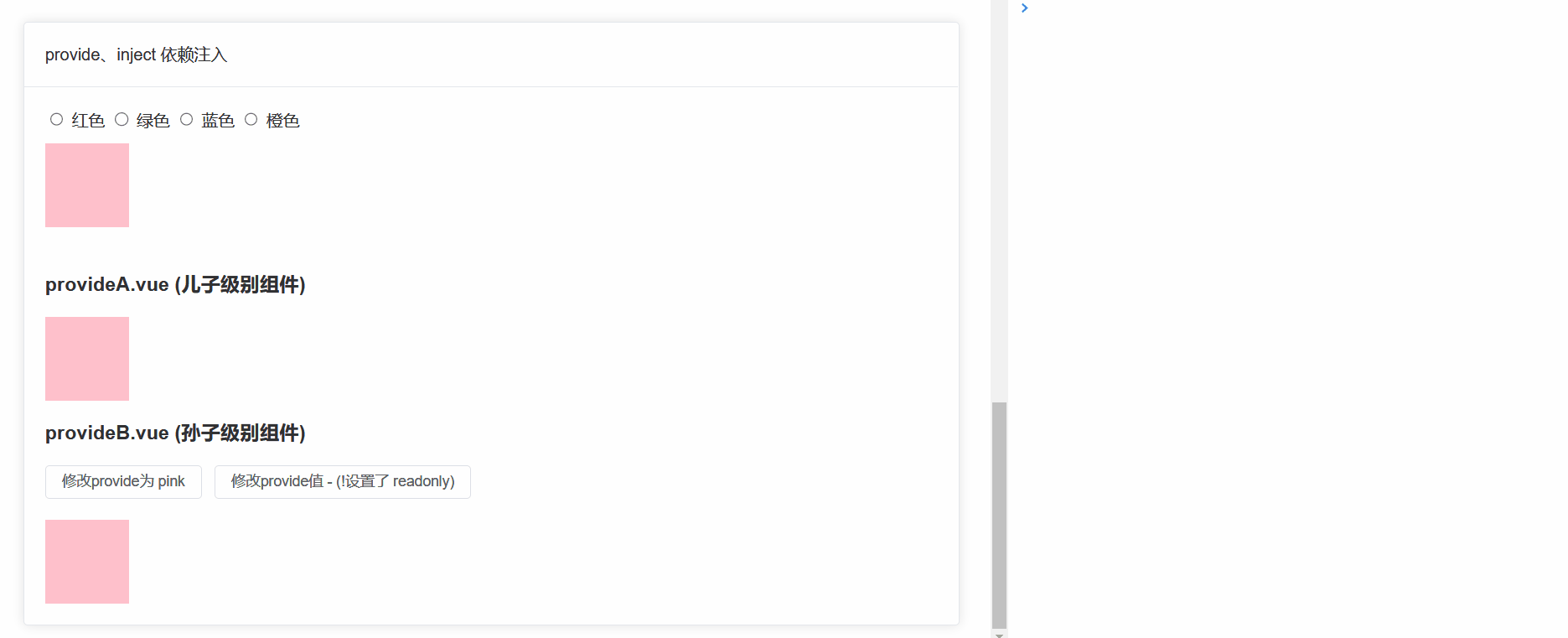
globalProperties 全局属性
const app = createApp(App);
app.config.globalProperties.$user = {
name: '梅长苏',
weapons: '长剑',
title: '刺客'
}
<p>姓名:{{$user.name}} </p>
const { proxy } = getCurrentInstance()
console.log(proxy.$user)
getCurrentInstance 获取组件实例
获取当前组件实例
const { proxy } = getCurrentInstance()
console.log(proxy.$user)
动态组件
动态组件就是:让多个组件使用同一个挂载点,并动态切换。
vue2 写法
<script>
import A from './z-a.vue'
import B from './z-b.vue'
import C from './z-c.vue'
export default {
components: { A, B, C },
data() {
return {
componentId: 'A', // 默认显示的组件
tabList: [
{ name: 'A组件', com: 'A' },
{ name: 'B组件', com: 'B' },
{ name: 'C组件', com: 'C' }
]
}
},
methods: {
changeTab(item) {
this.componentId = item.com
}
}
}
</script>
<template>
<div>
<div style="display: flex">
<div
v-for="(item, index) in tabList" :key="index"
class="tab-item"
:class="[{ active: item.com === componentId }]"
@click="changeTab(item)"
>
{{ item.name }}
</div>
</div>
<!-- 1. component标签是vue内置的 作用:组件的占位符 -->
<!-- 2. is属性的值,表示要渲染的组件的名字(组件在components节点下的注册名称) -->
<!-- 使用keep-alive 把组件进行缓存,而不是销毁组件 -->
<keep-alive>
<component :is="componentId" />
</keep-alive>
</div>
</template>

vue3 写法
在vue3中我们会尝试这么写:
<script setup>
import { markRaw, reactive, shallowRef } from 'vue'
import A from './z-a.vue'
import B from './z-b.vue'
import C from './z-c.vue'
const componentId = ref(A)
const tabList = reactive([
{
name: 'A组件',
com: A
},
{
name: 'B组件',
com: B
},
{
name: 'C组件',
com: C
}
])
function changeTab(item) {
componentId.value = item.com
}
</script>
<template>
<div>
<div style="display: flex">
<div
v-for="(item, index) in tabList" :key="index"
class="tab-item"
:class="[{ active: item.com === componentId }]"
@click="changeTab(item)"
>
{{ item.name }}
</div>
</div>
<component :is="componentId" />
</div>
</template>
<style scoped>
.tab-item {
border: solid 1px #ccc;
padding: 5px 10px;
margin: 5px;
cursor: pointer;
}
.active {
background-color: cornflowerblue;
}
</style>
在Vue2 的时候 is 是通过组件名称切换的, 在Vue3 setup 是通过组件实例切换的,这么写控制台会给出警告:
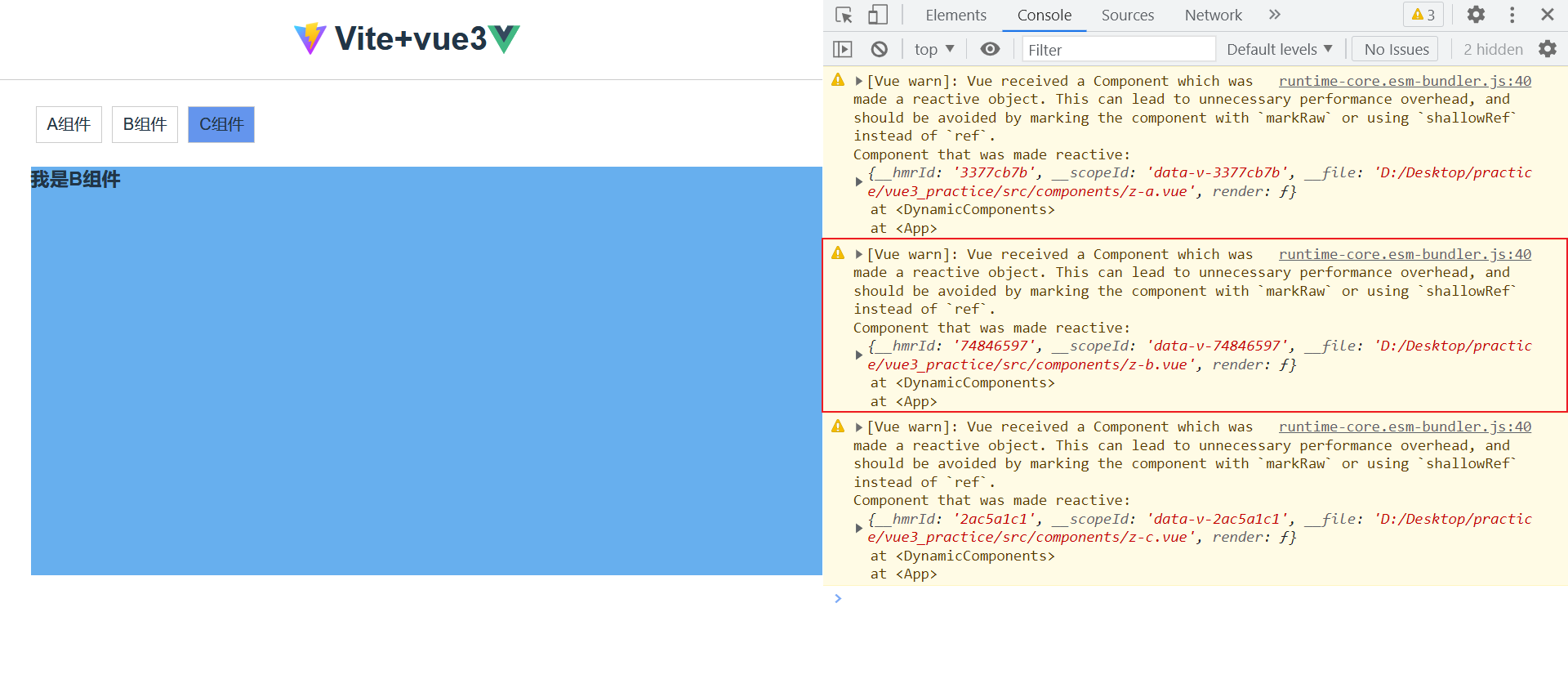
这是因为
reactive会进行proxy代理,而我们组件代理之后毫无用处,为了节省性能开销,vue推荐我们使shallowRef或者markRaw跳过proxy代理来标记组件或使用。
<script setup>
import { markRaw, reactive, shallowRef } from 'vue'
import A from './z-a.vue'
import B from './z-b.vue'
import C from './z-c.vue'
// 这里也需要使用 shallowRef 去指定默认的
const componentId = shallowRef(A)
const tabList = reactive([
{
name: 'A组件',
// vue源码中,使用markRaw时,会给这个对象加一个 __slip__属性,reactive如果碰到这个属性,会跳过 proxy 代理
com: markRaw(A)
},
{
name: 'B组件',
// 也可以使用 shallowRef 不进行对象的响应式处理
com: shallowRef(B)
},
{
name: 'C组件',
com: markRaw(C)
}
])
function changeTab(item) {
componentId.value = item.com
}
</script>
组合式写法
当然你也可以使用双 script 的方式来使用动态组件 (组合式和响应式api结合):
<script setup>
import { reactive, ref } from 'vue'
import A from './z-a.vue'
import B from './z-b.vue'
import C from './z-c.vue'
const componentId = ref('A')
const tabList = reactive([
{ name: 'A组件', com: 'A' },
{ name: 'B组件', com: 'B' },
{ name: 'C组件', com: 'C' }
])
function changeTab(item) {
componentId.value = item.com
}
</script>
<script>
// 使用vue2 的方式导入组件
export default {
components: { A, B, C }
}
</script>
slot 插槽
💭
插槽就是子组件中的提供给父组件使用的一个占位符,用 表示,父组件可以在这个占位符中填充任何模板代码,如 HTML、组件等,填充的内容会替换子组件的标签。
匿名插槽
- 定义一个子组件
<template>
<div>
<h3> 我是子组件 </h3>
<slot />
</div>
</template>
- 父组件使用,给子组件填充内容
<template>
<Children>
<!-- template写法使用插槽,在编译时会忽略这个标签 -->
<template #default>
<div>我是插槽内容!</div>
</template>
</Children>
</template>
/* 直接填充插槽写法
<Children>
<div>我是插槽内容!</div>
</Children>
*/
具名插槽
💭
具名插槽其实就是给插槽取个名字。一个子组件可以放多个插槽,而且可以放在不同的地方,而父组件填充内容时,可以根据这个名字把内容填充到对应插槽中。
<div>
<slot name="header"></slot>
<slot></slot>
<slot name="footer"></slot>
</div>
父组件使用:
<template>
<Children>
<template #header>
<div>我是头部插槽</div>
</template>
<template #default>
<div>我是默认插槽</div>
</template>
<template #footer>
<div>我是底部插槽</div>
</template>
</Children>
</template>
简写方式:
<template>
<Children>
<!-- header不传将会展示子组件内定义的默认样式 -->
<template #header>
<div>我是头部插槽</div>
</template>
<template #default>
<div>我是默认插槽</div>
</template>
<template #footer>
<div>我是底部插槽</div>
</template>
</Children>
</template>
作用域插槽
在子组件动态绑定参数,派发给父组件的slot去使用。
<script setup lang="ts">
import { reactive } from 'vue'
interface names {
name: string
age: number
}
const data = reactive<names[]>([
{ name: 'liaoyi', age: 22 },
{ name: '李欣', age: 24 },
{ name: '夏琪', age: 20 },
{ name: '张三', age: 26 }
])
</script>
<template>
<div class="child">
<slot name="header" />
<div v-for="(item, index) in data" :key="index">
<slot :data="item" />
</div>
<slot name="footer" />
</div>
</template>
父组件通过ES6解构方式获取值:
<template>
<Children>
<template #header>
<div>我是头部插槽</div>
</template>
<template #default="{ data, index }">
<div>{{ index }} -- {{ data.name }} -- {{ data.age }}</div>
</template>
<template #footer>
<div>我是底部插槽</div>
</template>
</Children>
</template>
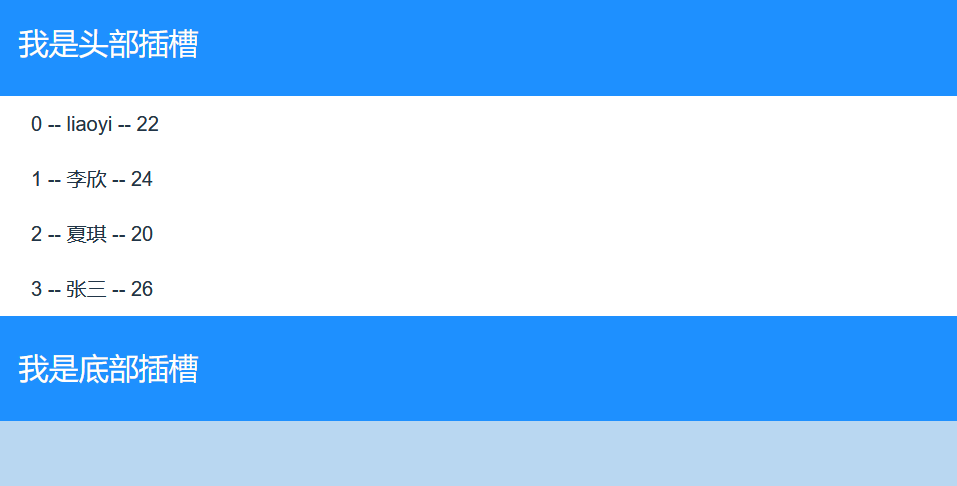
动态插槽
插槽可以是一个变量名
<script setup>
import { ref } from 'vue'
const slotName = ref('header')
</script>
<template>
<Children>
<template #[name]>
<div> 动态插槽 </div>
</template>
</Children>
<button @click="slotName = 'default'">
修改插槽
</button>
</template>
keep-alive 缓存组件
💭
有时候我们不希望组件被重新渲染影响使用体验 (比如切换多个表单组件时不想表单被清空), 或者处于性能考虑,避免多次重复渲染降低性能。而是希望组件可以缓存下来,维持当前的状态。这时候就需要用到keep-alive组件。
开启 keep-alive 后会新增两个生命周期,onActivated 和 onDeactivated。 下面是生命周期变化:
- 初次进入时: 先触发
onMounted然后触发onActivated - 退出后触发
onDeactivated - 再次进入:只会触发
onActivated
💭
所以我们可以从上总结出,如果一些组件中定义的方法,只想执行一次,就放在 onMounted 中,如果组件每次进入后都要执行的方法就放在 onActivated 中。
基本使用
<!-- 基本 -->
<keep-alive>
<component :is="view"></component>
</keep-alive>
<!-- 多个条件判断的子组件 -->
<keep-alive>
<comp-a v-if="a > 1"></comp-a>
<comp-b v-else></comp-b>
</keep-alive>
<!-- 和 `<transition>` 一起使用 -->
<transition>
<keep-alive>
<component :is="view"></component>
</keep-alive>
</transition>
include 和 exclude
include和exclude允许组件有条件地缓存。二者都可以用逗号分隔字符串、正则表达式或一个数组来表示。
<!-- 注意在 setup语法糖中,组件name 默认为组件文件名 -->
// include 定义需要缓存的组件
<keep-alive :include="['compA','compB']">
<compA />
<compB />
</keep-alive>
// exclude: 定义不缓存的组件
<keep-alive :exclude="['compA']">
<compA />
<compB />
</keep-alive>
// max: 指定缓存组件的最大数量 (比如有11个组件,只想缓存9个) 会优先缓存活跃组件
<keep-alive :max="10">
<component :is="view"></component>
</keep-alive>
自定义hook函数
- 什么是hook?—— 本质是一个函数,把setup函数中使用的
Composition API进行了封装。 - 类似于
vue2.x中的mixin。 - 自定义
hook的优势: 复用代码, 让setup中的逻辑更清楚易懂。
其它 Composition API
vue3 到底给我们提供了多少 API 呢,我们可以在main.js中输出一下:
import * as Vue from 'vue';
console.dir(Vue);
控制台输出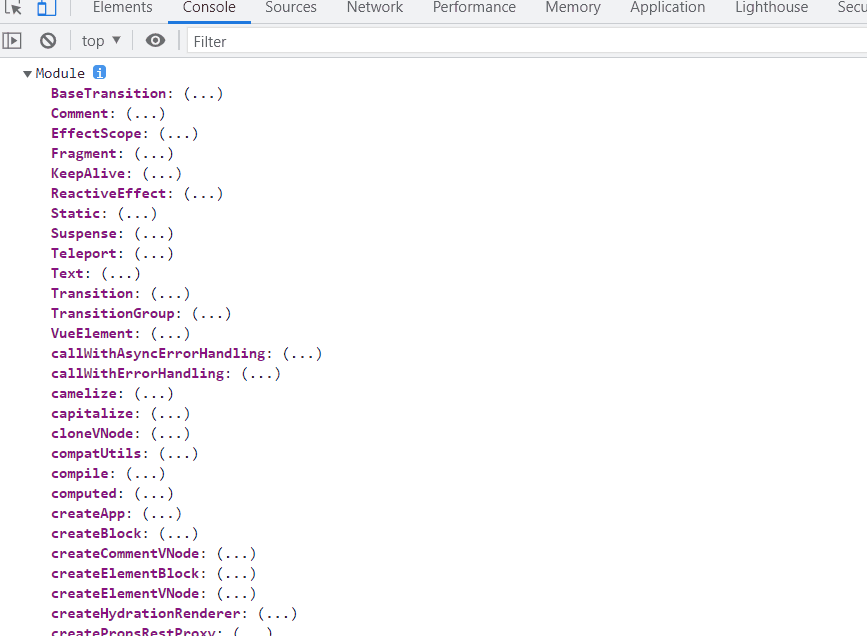
ref 其它 api
isRef
isRef: 用与判断是不是一个ref对象, vue源码中用的比较多。
import { ref,isRef } from 'vue'
let message: Ref<string | number> = ref("我是message")
let notRef:number = 123
const changeMsg = () => {
message.value = "change msg"
console.log(isRef(message)); //true
console.log(isRef(notRef)); //false
}
shallowRef
shallowRef:只处理基本数据类型的响应式, 不进行对象的响应式处理。
<template>
<div>
<button @click="changeRef">改变ref</button>
<button @click="changeShallowRef">改变shallowRef</button>
<div>ref: {{ refObj.name }}</div>
<hr>
<div>shallowRef: {{ shallowRefObj.name }}</div>
</div>
</template>
<script setup>
import { ref, shallowRef } from 'vue'
// ref 深层次响应数据 shallowRef 浅层次响应数据
let refObj = shallowRef({
name: "liaoyi"
})
// 创建一个跟踪自身 .value 变化的 ref,但不会使其值也变成响应式的
let shallowRefObj = shallowRef({
name: "liaoyi"
})
const changeRef = () => {
refObj.value.name = '王二狗'
}
const changeShallowRef = () => {
// 因为其属性是非响应式,虽然数据变了但是页面不会更新
shallowRefObj.value.name = '张全蛋'
// 我们可以给shallowRefMessage对象直接复赋值
shallowRefObj.value = { name: '李四' }
}
// 下面这种写法是错误的
// ref 和 shallowRef 不能一起使用,会影响shallowRef 造成视图更新
const changeMsg = () => {
refObj.value.name = '王二狗'
shallowRefMessage.value = '我被影响了,导致视图更新!'
}
</script>
triggerRef
triggerRef: 用于强制更新页面DOM。
上面的代码里,我们在一个方法中同时修改ref和 shallowRef 值,出现了影响 shallowRef 造成视图更新的现象,那这个问题是如何产生的呢 ?这时候我们就可以介绍 triggerRef 。因为使用 ref 更改值的时候,ref 底层中会调用一次 triggerRef 方法,所以才会影响 shallowRef 造成视图更新。为了更好的理解,你也可以把ref想象成 shallowRef + triggerRef 结合。
<template>
<div>
<button @click="changeMsg">change</button>
<div>{{ message }}</div>
</div>
</template>
<script setup>
import { Ref, shallowRef,triggerRef } from 'vue'
let message = shallowRef({
name: "小满"
})
const changeMsg = () => {
message.value.name = '大满'
triggerRef(message)
}
</script>
<style>
</style>
customRef
作用:用于创建一个自定义的 ref,并对其依赖项跟踪和更新触发进行显式控制。
如实现防抖效果:
<!-- 简单理解: customRef 是个工厂函数 -->
<!-- 要求我们返回一个对象 并且实现 get 和 set 适合去做防抖之类的 -->
<script setup>
import { customRef, ref } from 'vue'
// let keyword = ref('hello') //使用Vue准备好的内置ref
//自定义一个myRef
function myRef(value, delay) {
let timer
/**
* 通过customRef去实现自定义
* @param { callback } track - 用于收集依赖
* @param { callback } trigger - 用于处理依赖
*/
return customRef((track, trigger)=>{
return {
get() {
track() //告诉Vue这个value值是需要被“追踪”的
return value
},
set(newValue) {
clearTimeout(timer)
timer = setTimeout(()=>{
value = newValue
trigger() //告诉Vue去更新界面
}, delay)
}
}
})
}
const keyword = myRef('hello', 500) //使用程序员自定义的ref
</script>
<template>
<input v-model="keyword" type="text">
<h3>{{ keyword }}</h3>
</template>
reactive 其它api
shallowReactive
shallowReactive:只处理对象最外层属性的响应式(浅响应式)。
<script setup lang="ts">
import { shallowReactive } from 'vue'
const obj = {
a: 1,
first: {
b: 2,
second: {
c: 3
}
}
}
const state = shallowReactive(obj)
function change1() {
// 虽然 state.a 值改变了,但视图不会更新
state.a = 7
}
function change2() {
// 只能到获取到对象的第一层数据
state.first.b = 8
state.first.second.c = 9
console.log(state)
}
</script>
<template>
<div>
<div>{{ state }}</div>
<button @click="change1">
test1
</button>
<button @click="change2">
test2
</button>
</div>
</template>
readonly 与 shallowReadonly
readonly: 让一个响应式数据变为只读,并且是深度只读(深只读)。
<script setup lang="ts">
import { reactive, readonly, ref, } from 'vue'
const state = reactive({
name:'liaoyi',
age:12,
car:{
name:'奔驰',
color:'red'
}
})
const state2 = readonly(state)
function update() {
// 无法修改 state2为只读
state2.name += '---'
state2.car.name += '---'
}
</script>
<template>
<h2>readonly</h2>
<h3> {{ state }}</h3>
<button @click="update">
更新数据
</button>
</template>
shallowReadonly:让一个响应式数据变成浅层的属性为只读,深层次属性可以修改(浅只读)。
<script setup lang="ts">
import { reactive, readonly, ref, } from 'vue'
const state = reactive({
name:'liaoyi',
age:12,
car:{
name:'奔驰',
color:'red'
}
})
const state2 = shallowReadonly(state)
function update() {
// state2.name += '---' 无法修改浅层次值
state2.car.name += '---' // 深层次值可以被修改
console.log('数据变化了~')
}
</script>
💭
应用场景:不希望数据被修改时。
什么时候使用 shallowReactive 与 shallowRef ?
💭
- 如果有一个对象数据,结构比较深, 但变化时只是外层属性变化 ===> shallowReactive。
- 如果有一个对象数据,后续功能不会修改该对象中的属性,而是生新的对象来替换 ===> shallowRef。
toRef 与 toRefs
toRef
toRef 只能用于响应式数据,非响应式数据使用时视图不会有变化 (毫无卵用)。 使用: 接收两个参数:第一个参数是响应式对象,第二个参数为对象的key。 类似于vue2中的$set。
<script setup lang="ts">
import { reactive, toRef } from 'vue'
const obj = { foo: 1, bar: 1 }
// bar 转化为响应式对象
const state = toRef(obj, 'bar')
const main = reactive({ name: 'liaoyi', like: 'Code' })
const like = toRef(obj, 'like')
function change() {
// 数据虽然发生变化,但是视图不会更新
state.value ++
console.log(obj, state)
}
function changeState() {
like.value = 'reap'
console.log(like)
}
</script>
<template>
<div>
<button @click="change">
非响应式数据使用toRef后修改值
</button>
<button @click="changeState">
响应式数据使用toRef后修改值
</button>
{{ state }}
</div>
</template>
toRefs
前面我们其实使用过toRefs,它批量创建ref对象,方便我们解构使用。
import { reactive, toRefs } from 'vue'
const obj = reactive({
foo: 1,
bar: 1
})
const { foo, bar } = toRefs(obj)
foo.value++
console.log(foo, bar)
toRaw 与 markRaw
toRaw
- 作用:将一个由
reactive生成的 响应式对象 转为 普通对象。 - 使用场景:用于读取响应式对象对应的普通对象,对这个普通对象的所有操作,不会引起页面更新。
import { reactive, toRaw } from 'vue'
const obj = reactive({
foo: 1,
bar: 1
})
const state = toRaw(obj)
// 响应式对象转化为普通对象
function change() {
console.log(obj, state)
}
markRaw
**markRaw**: 用于标记一个对象,使其永远不会再成为响应式对象。 **应用场景: **
- 有些值不应被设置为响应式的,例如复杂的第三方类库等。
- 当渲染具有不可变数据源的大列表时,跳过响应式转换可以提高性能。
响应式数据的判断
isRef: 检查一个值是否为一个 ref 对象 isReactive: 检查一个对象是否是由 reactive 创建的响应式代理 isReadonly: 检查一个对象是否是由 readonly 创建的只读代理 isProxy: 检查一个对象是否是由 reactive 或者 readonly 方法创建的代理
vuex 使用
vue3中使用的是vuex4版本,我们不在使用import方式导入vuex,而是使用官方提供的函数式api方式使用。参考链接:vuex4.x 官网
- 在项目根目录 新建
store/index.js文件:
import { createStore, createLogger } from 'vuex';
const env = process.env.NODE_ENV; // 开发环境变量
const store = createStore({
state: { x: 0, y: 10 },
mutations: {
changeX(state, payload = 1) {
state.x += +payload;
},
changeY(state, payload = 1) {
state.y -= +payload;
}
},
actions: {
changeYAsync({ commit }, payload) {
setTimeout(() => {
commit('changeY', payload);
}, 1000);
}
},
// 开发环境开启Logger调试
plugins: env === "production" ? [] : [createLogger()]
});
export default store
💭
createLogger 是vuex内置的插件,方便我们在开发时使用vuex时控制台返回日志输出,如果你不了解vuex内置插件 Vuex 内置 Logger 插件。
- 在
main.j文件上导入store:
import { createApp } from 'vue';
import App from './App.vue';
import store from './store/index';
const app = createApp(App);
app.use(store);
app.mount('#app');
- 在组件中使用
<template>
测试Vuex公共状态管理
x:{{ x }}
y:{{ y }}
<button @click="setX(10)">改变X</button>
<button @click="setY(2)">改变Y</button>
</template>
<script>
import { computed, ref, reactive } from "vue"
import { useStore } from "vuex"
export default {
name: "Test",
setup() {
const store = useStore();
let x = computed(() => store.state.x)
let y = computed(() => store.state.y)
const setX = (val) => {
store.commit("changeX", val)
}
const setY = (val) => {
store.dispatch("changeYAsync", val)
}
return { x, y, setX, setY };
},
};
</script>
注意:在vue3中的setup中无法通过辅助函数的方式操作store。
Router 使用
- 在根目录新建
router/index.js文件写入:
import { createRouter, createWebHashHistory } from "vue-router";
import Vote from "@/pages/Vote.vue";
import Test from "@/pages/Test.vue";
const routes = [{
path: '/',
component: Vote,
}, {
path: '/test',
component: Test,
}, {
path: '/:pathMatch(.*)*',
redirect: '/'
}]
const router = createRouter({
history: createWebHashHistory(),
routes
})
export default router;
- 在main.js 导入
import { createApp } from 'vue';
import App from './App.vue';
import router from "./router/index";
const app = createApp(App);
app.use(router);
app.mount('#app');
其他改变
全局API的转移
Vue 2.x 有许多全局 API 和配置, 例如:注册全局组件、注册全局指令等。
//注册全局组件
Vue.component('MyButton', {
data: () => ({
count: 0
}),
template: '<button @click="count++">Clicked {{ count }} times.</button>'
})
//注册全局指令
Vue.directive('focus', {
inserted: el => el.focus()
}
💭
Vue3.0 中对这些API做出了调整, 将全局的 API,即:Vue.xxx调整到应用实例(app)上。
| 2.x 全局 API(Vue) | 3.x 实例 API (app) |
|---|---|
| Vue.config.xxxx | app.config.xxxx |
| Vue.config.productionTip | 移除 |
| Vue.component | app.component |
| Vue.directive | app.directive |
| Vue.mixin | app.mixin |
| Vue.use | app.use |
| Vue.prototype | app.config.globalProperties |
globalProperties
💭
由于Vue3 没有 Prototype 属性,需要使用 app.config.globalProperties ,去定义变量和函数。
// Vue 2
// Vue.prototype.$http = () => {}
// Vue 3
import { createApp } from 'vue'
import App from './App.vue'
const app = createApp(App)
app.mount('#app')
// 定义全局变量
app.config.globalProperties.$env = 'dev'
// 定义全局方法
app.config.globalProperties.$http = () => {}
// vue3已经移除了过滤器 我们可以使用全局函数代替 filters
app.config.globalProperties.$filters = {
format<T extends any>(str: T): string {
return `filters-${str}`
}
}
在页面中使用:
<template>
<!-- 在template中可以直接使用 -->
<div> {{ $env }}</div>
<div> {{ $filters.format('Hello') }}</div>
</template>
<script setup lang="ts">
// 在js里使用 全局变量和方法有两种方式
// 第一种:引入 getCurrentInstance 用于获取当前实例
import { getCurrentInstance } from 'vue';
const app = getCurrentInstance()
console.log(app?.proxy?.$filters.format('typescript'))
console.log(app?.proxy?.$env)
// 第二种:引入 ComponentInternalInstance
import { ComponentInternalInstance } from 'vue';
const { appContext } = <ComponentInternalInstance>getCurrentInstance()
console.log(appContext.config.globalProperties.$env)
</script>
这里如果使用 typescript 的话,因为没有声明文件 ,TS无法正确类型,推导时会报错:
// <!-- 我们在main.ts中自己手动加入声明文件 -->
interface Filter {
format<T>(str: T): string
}
// 声明要扩充@vue/runtime-core包的声明.
// 这里扩充"ComponentCustomProperties"接口, 因为他是vue3中实例的属性的类型.
declare module 'vue' {
export interface ComponentCustomProperties {
$filters: Filter
}
}
其他改变
data选项应始终被声明为一个函数。- 过度类名的更改:
.v-enter,
.v-leave-to {
opacity: 0;
}
.v-leave,
.v-enter-to {
opacity: 1;
}
Vue3.x写法
.v-enter-from,
.v-leave-to {
opacity: 0;
}
.v-leave-from,
.v-enter-to {
opacity: 1;
}
- 移除
keyCode作为v-on的修饰符,同时也不再支持config.keyCodes - 移除
v-on.native修饰符
<my-component
v-on:close="handleComponentEvent"
v-on:click="handleNativeClickEvent"
/>
<script>
export default {
emits: ['close']
}
</script>
移除过滤器(filter)
💭
过滤器虽然这看起来很方便,但它需要一个自定义语法,打破大括号内表达式是 “只是 JavaScript” 的假设,这不仅有学习成本,而且有实现成本!建议用方法调用或计算属性去替换过滤器。
vueUse
useCssVar
const el = ref(null);
const cssVar = useCssVar('--el-color-primary', el);
// 等同于
const el = document.documentElement;
getComputedStyle(el).getPropertyValue('--el-color-primary')
/**
1. 当属性--primary不存在时 默认 #d060d0
2. 设置属性: document.getElementById('app').style.setProperty('--primary', 'red');
2. 获取属性: document.getElementById('app').style.getPropertyValue('--primary')
3. 通过以上方法设置主题
*/
$primary: var(--el-color-primary);
节流
const debouncedFn = useDebounceFn((entries) => {
const entry = entries[0];
const { width } = entry.contentRect;
console.log('output=>', width);
}, 1000);
useResizeObserver(app, debouncedFn);
源码解析
toRef
如果是 ref 对象直接返回 否则 调用 ObjectRefImpl 创建一个类ref对象
export function toRef<T extends object, K extends keyof T>(
object: T,
key: K,
defaultValue?: T[K]
): ToRef<T[K]> {
const val = object[key]
return isRef(val)
? val
: (new ObjectRefImpl(object, key, defaultValue) as any)
}
类 ref 对象只是做了值的改变并未处理 收集依赖和触发依赖的过程 所以 普通对象无法更新视图
class ObjectRefImpl<T extends object, K extends keyof T> {
public readonly __v_isRef = true
constructor(
private readonly _object: T,
private readonly _key: K,
private readonly _defaultValue?: T[K]
) {}
get value() {
const val = this._object[this._key]
return val === undefined ? (this._defaultValue as T[K]) : val
}
set value(newVal) {
this._object[this._key] = newVal
}
}
keep-alive 源码
💭
- 源码目录 runtime-core/src/components/KeepAlive.ts
props
props: {
// 配置了该属性,那么只有名称匹配的组件会被缓存
include: [String, RegExp, Array],
// 配置了该属性,那么任何名称匹配的组件都不会被缓存
exclude: [String, RegExp, Array],
// 最多可以缓存多少组件实例
max: [String, Number]
},
setup(props: KeepAliveProps, { slots }: SetupContext) {
const instance = getCurrentInstance()!
const sharedContext = instance.ctx as KeepAliveContext
})
const { include, exclude, max } = props
//如果include 子组件名称 不包含, 和 exclude包含的名字 就不该缓存 直接返回
if (
(include && (!name || !matches(include, name))) ||
(exclude && name && matches(exclude, name))
) {
current = vnode
return rawVNode
}
watch(
() => [props.include, props.exclude],
([include, exclude]) => {
//props 是响应式的 所以这个操作需要在做一遍
include && pruneCache(name => matches(include, name))
exclude && pruneCache(name => !matches(exclude, name))
},
// prune post-render after `current` has been updated
{ flush: 'post', deep: true }
)
缓存设计
//KeepAlive 组件的缓存管理
const cache: Cache = new Map()
const keys: Keys = new Set()
let pendingCacheKey: CacheKey | null = null
//缓存函数
const cacheSubtree = () => {
// fix #1621, the pendingCacheKey could be 0
if (pendingCacheKey != null) {
cache.set(pendingCacheKey, getInnerChild(instance.subTree))
}
}
//KeepLive 组件中对缓存的管理时,首先会在组件的 onMounted 或 onUpdated 生命周期钩子函数中设置缓存,如下代码所示:
onMounted(cacheSubtree)
onUpdated(cacheSubtree)
//Vnode 的key 作为缓存的key
pendingCacheKey = key
//KeepLive组件返回的函数中根据 vnode 对象的 key 去缓存中查找是否有缓存的组件,
//如果缓存存在,则继承组件实例,并将用于描述组件的 vnode 对象标记为 COMPONENT_KEPT_ALIVE,
//这样渲染器就不会重新创建新的组件实例;如果缓存不存在,则将 vnode 对象的key 添加到 keys 集合中
if (cachedVNode) {
// 如果缓存中存在缓存的组件,直接读取缓存实例
vnode.el = cachedVNode.el
vnode.component = cachedVNode.component
//无须创建组件实例,继承缓存的组件即可
if (vnode.transition) {
// 如果组件上有动画,处理动画
setTransitionHooks(vnode, vnode.transition!)
}
// 标记Vnode 不会重新渲染
vnode.shapeFlag |= ShapeFlags.COMPONENT_KEPT_ALIVE
// make this key the freshest
keys.delete(key)
keys.add(key)
} else {
//将 vnode 的key 添加到 keys 集合中,keys 集合用户维护缓存组件的 key
keys.add(key)
// prune oldest entry
if (max && keys.size > parseInt(max as string, 10)) {
pruneCacheEntry(keys.values().next().value)
}
}
生命周期
//隐藏容器
const storageContainer = createElement('div')
//在实例上注册两个钩子函数 activate, deactivate
sharedContext.activate = (vnode, container, anchor, isSVG, optimized) => {
const instance = vnode.component!
move(vnode, container, anchor, MoveType.ENTER, parentSuspense)
// props 可能会发生变化,因此需要执行 patch 过程
patch(
instance.vnode,
vnode,
container,
anchor,
instance,
parentSuspense,
isSVG,
vnode.slotScopeIds,
optimized
)
queuePostRenderEffect(() => {
instance.isDeactivated = false
if (instance.a) {
invokeArrayFns(instance.a)
}
const vnodeHook = vnode.props && vnode.props.onVnodeMounted
if (vnodeHook) {
invokeVNodeHook(vnodeHook, instance.parent, vnode)
}
}, parentSuspense)
if (__DEV__ || __FEATURE_PROD_DEVTOOLS__) {
// Update components tree
devtoolsComponentAdded(instance)
}
}
sharedContext.deactivate = (vnode: VNode) => {
const instance = vnode.component!
//将组件移动到隐藏容器中
//在 “卸载” 组件时,并不是真正的卸载,而是调用 move 方法,将组件搬运到一个隐藏的容器中
move(vnode, storageContainer, null, MoveType.LEAVE, parentSuspense)
queuePostRenderEffect(() => {
if (instance.da) {
invokeArrayFns(instance.da)
}
const vnodeHook = vnode.props && vnode.props.onVnodeUnmounted
if (vnodeHook) {
invokeVNodeHook(vnodeHook, instance.parent, vnode)
}
instance.isDeactivated = true
}, parentSuspense)
if (__DEV__ || __FEATURE_PROD_DEVTOOLS__) {
// Update components tree
devtoolsComponentAdded(instance)
}
}